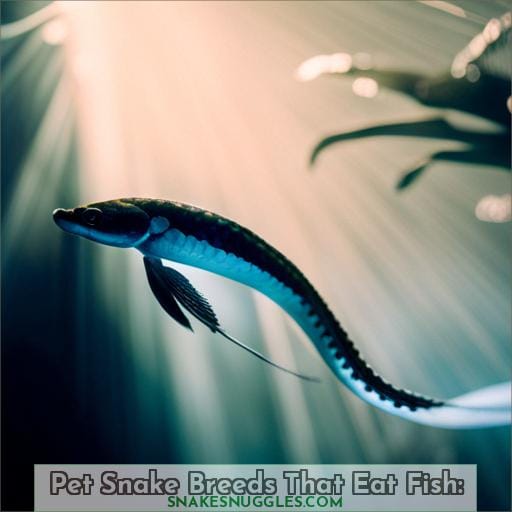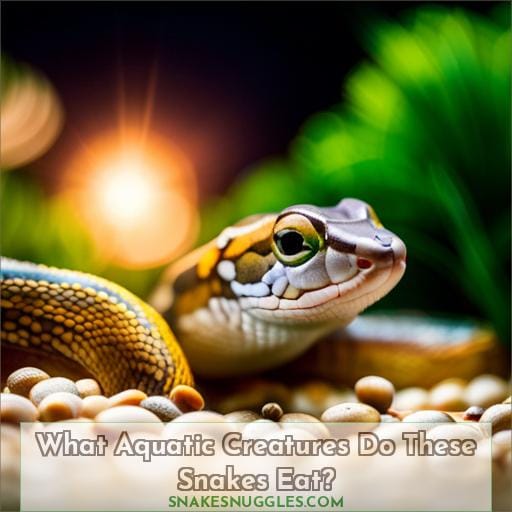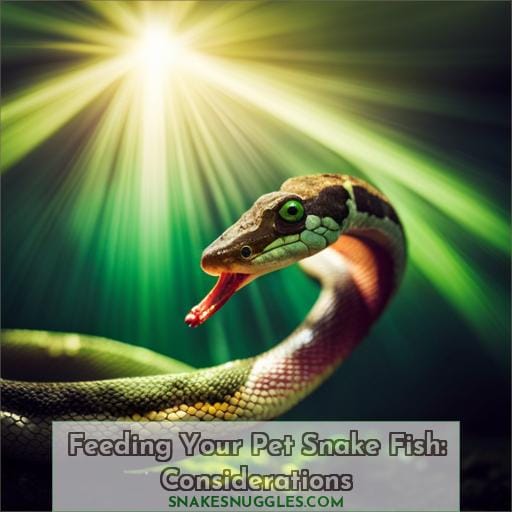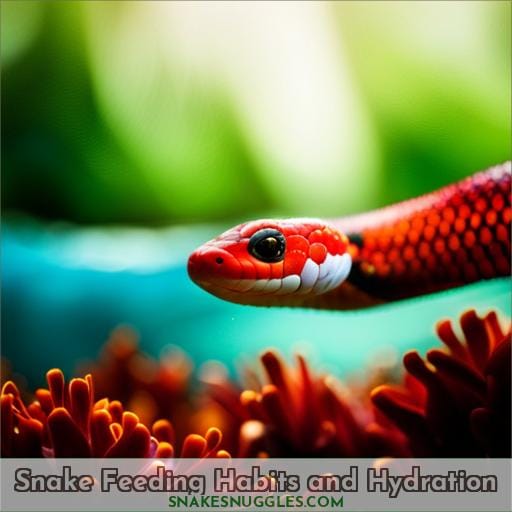This site is supported by our readers. We may earn a commission, at no cost to you, if you purchase through links.
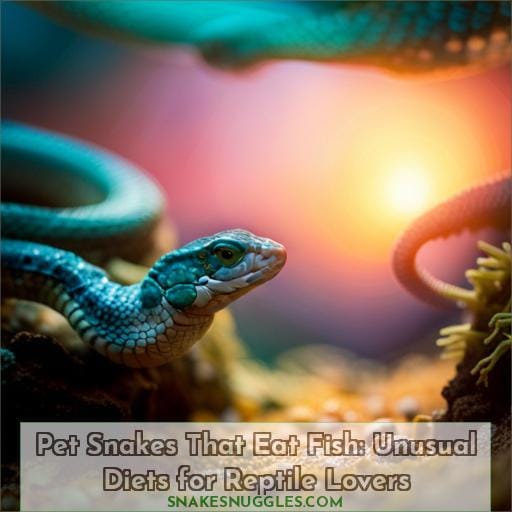 Imagine owning a pet snake that devours fish instead of the usual prey. It’s an unusual diet, but for reptile lovers seeking something different, it can be fascinating to explore. While most snakes aren’t equipped to handle sharp fish bones properly or skilled enough at fishing for it to be their primary food source, there are some breeds that enjoy consuming fish.
Imagine owning a pet snake that devours fish instead of the usual prey. It’s an unusual diet, but for reptile lovers seeking something different, it can be fascinating to explore. While most snakes aren’t equipped to handle sharp fish bones properly or skilled enough at fishing for it to be their primary food source, there are some breeds that enjoy consuming fish.
In this article, we’ll delve into these unique pet snake breeds and discuss the considerations and troubleshooting involved in feeding them a piscivorous diet.
Table Of Contents
- Key Takeaways
- Pet Snake Breeds That Eat Fish:
- What Aquatic Creatures Do These Snakes Eat?
- Feeding Your Pet Snake Fish: Considerations
- Troubleshooting: My Pet Snake Won’t Eat Fish
- What Do Snakes Eat?
- Snake Feeding Habits and Hydration
- Frequently Asked Questions (FAQs)
- How often should I feed my pet snake fish?
- Can I feed my pet snake other types of fish besides guppies?
- What are some other food options if my pet snake won’t eat fish?
- Do snakes need any additional vitamins or supplements when eating fish?
- How should I provide water for my pet snake and how often should I change it?
- Conclusion
Key Takeaways
- Garter snakes, water snakes, and ribbon snakes are pet snake breeds that eat fish as part of their diets.
- Fish can provide behavioral stimulation for snakes, but it is important to research safe fish options to avoid potentially harmful enzymes.
- If a snake refuses to eat fish, alternative food options such as earthworms or insects can be offered.
- Regular veterinary visits are crucial for addressing feeding issues and ensuring the overall health of pet snakes.
Pet Snake Breeds That Eat Fish:
Let’s explore some pet snake breeds that have a taste for fish.
The garter snake, watersnake, and ribbon snake are among the reptiles that enjoy including fish in their diet. These species have adapted to hunting and consuming aquatic creatures like small fish as part of their natural feeding habits.
Garter Snake
If you’re looking for a pet snake that enjoys a diet of fish, consider the garter snake. This species is known to consume various aquatic prey items, including small fish.
Garter snakes are found in a wide range of habitats across North America, from forests and grasslands to wetlands and marshes. They’ve an average lifespan of around 5-10 years in captivity but can live longer in ideal conditions.
Natural predators include birds of prey and larger mammals. Reproduction occurs through the laying of eggs.
Watersnake
To properly care for your watersnake, understand its unique dietary needs as a pet snake that eats fish.
Watersnakes are aquatic snakes found in various habitats like swamps and lakes. Their diet consists mainly of fish, with guppies being a popular choice.
These snakes exhibit different feeding preferences compared to other snake breeds due to their natural habitat and behavioral patterns.
When feeding them live fish, it’s important to consider health considerations such as the potential presence of harmful enzymes in certain types of fish.
Ribbon Snake
Continuing the discussion on pet snake breeds that eat fish, let’s explore the Ribbon Snake and its unique diet preferences.
- Ribbon Snake Behavior: These slender reptiles are semi-aquatic and highly skilled swimmers.
- Habitat Enrichment: Providing a spacious enclosure with plenty of climbing branches and hiding spots is essential for their mental stimulation.
- Breeding Challenges: Successfully breeding ribbon snakes can be challenging due to specific temperature requirements during mating season.
- Health Checkups: Regular veterinary checkups are crucial to monitor their overall health and detect any potential issues early on.
- Substrate Selection: Choosing an appropriate substrate like cypress mulch or aspen bedding helps maintain proper humidity levels in their habitat.
What Aquatic Creatures Do These Snakes Eat?
The aquatic creatures that these snakes eat vary depending on the species.
Water snakes have a diet that includes:
- Insects
- Worms
- Small fish
- Rodents
- Occasionally frogs
Garter snakes primarily consume:
- Worms
- Small fish
- Rodents
Ribbon snakes enjoy:
- Crickets
- Earthworms
- Nightcrawlers
- Silverside
- Guppies
- Tadpoles
- And of course,
- Rodents
Water Snake: Insects, Worms, Small Fish, Rodents, and Sometimes the Occasional Frog
When feeding your water snake, you can offer a variety of prey items including:
- Insects, such as crickets
- Worms, such as earthworms
- Small fish, such as guppies
- Rodents, such as mice
These aquatic creatures provide a diverse diet for these snakes.
Garter Snake: Worms, Small Fish, and Rodents
You can also feed garter snakes a variety of aquatic creatures, including worms, small fish, and rodents.
Garter snakes are known for their adaptability and can thrive in various habitats such as grasslands, forests, wetlands, and even urban areas. When it comes to food preferences, garter snakes have a diverse diet that includes both terrestrial and aquatic prey.
In captivity, enriching their diets with healthy fish prey not only meets their nutritional needs but also provides mental stimulation by mimicking natural hunting behaviors.
Adapting tank environments to include water features allows these semi-aquatic snakes to exhibit their natural foraging behavior while ensuring they’ve access to appropriate sources of hydration.
Ribbon Snake: Crickets, Earthworms, Nightcrawlers, Silverside, Guppies, Tadpoles, and Rodents
When feeding your Ribbon snake, they have a diverse diet that includes crickets, earthworms, nightcrawlers, silverside fish, guppies, tadpoles and rodents.
Ribbon snakes are known for their agility and active behavior in both aquatic and terrestrial environments.
To provide optimal tank enrichment for your pet ribbon snake, include hiding spots such as rocks or branches to mimic their natural habitat.
When handling ribbon snakes, it’s important to support their body properly to prevent injury.
Breeding insights suggest providing a separate mating enclosure with appropriate temperature and humidity levels.
Lastly, regular health check-ups by a reptile veterinarian can ensure the overall well-being of your ribbon snake.
Feeding Your Pet Snake Fish: Considerations
When considering feeding your pet snake fish, there are a few important considerations to keep in mind.
Firstly, some fish contain enzymes that can be harmful to snakes, so it’s crucial to research which types of fish are safe for your specific snake species.
Additionally, you’ll need to decide whether to feed your snake dead or live fish; while dead fish require less maintenance and may be easier for the snake to swallow, live ones provide more enjoyment and potentially increase the reptile’s overall happiness.
Enzymes in Fish That Can Harm Snakes
To ensure the health and well-being of your pet snake, it’s important to be aware of the enzymes present in fish that can potentially harm them.
Some fish contain enzymes that may not agree with snakes’ digestive systems. These enzymes can cause issues such as gastrointestinal upset or even organ damage if consumed regularly or in large quantities.
When feeding your pet snake fish, it’s crucial to consider these dietary considerations and choose fish species that are safe for consumption.
Additionally, keep an eye out for any signs of discomfort after feeding, such as regurgitation or lethargy, as this could indicate a negative reaction to the fish’s enzymes.
By being mindful of these factors and monitoring your snake’s feeding preferences closely, you can provide a healthy diet while minimizing potential risks associated with consuming certain types of fish.
Pros and Cons of Feeding Dead Vs. Live Fish
Feeding your pet snake dead fish offers convenience and lower maintenance, while live fish provide a more enjoyable experience for your reptile.
- Nutritional Differences:
- Live fish can offer fresher nutrients compared to frozen or preserved ones found in dead fish.
- Behavioral Stimulation:
- Hunting and capturing live prey can fulfill natural instincts in snakes, providing mental stimulation.
- Digestive Challenges:
- Live prey may pose a risk of injury to the snake during feeding, while digesting whole deceased fishes is generally easier.
- Owner Convenience:
- Dead fishes are readily available and require less effort for storage and preparation than maintaining a constant supply of live prey for feedings.
Troubleshooting: My Pet Snake Won’t Eat Fish
If your pet snake refuses to eat fish, there are a few troubleshooting options you can try.
First, consider offering alternative food options such as earthworms or insects like crickets or grasshoppers.
If your snake doesn’t like guppies, experiment with different types of small fish such as:
- Brook trout
- Sunfish
- Smallmouth bass
- Minnows
- Bullhead catfish
Trying Alternative Food Options (earthworms, Insects)
If your pet snake refuses to eat fish, you can try offering alternative food options such as earthworms or insects. These insectivorous alternatives provide a nutritious and enticing meal for your reptile friend.
Earthworm delicacies are rich in protein and can be easily sourced from gardens or purchased at pet stores. Insects like crickets, grasshoppers, and mealworms offer variety in texture and taste while providing essential nutrients for your snake’s overall health.
By incorporating these customized meal plans into their diet, you can ensure that your pet enjoys a balanced diet while maintaining their rodent-free lifestyle.
| Insectivorous Alternatives | Benefits | Availability |
|---|---|---|
| Earthworms | High protein content; easy to find | Gardens/Pet Stores |
| Crickets | Varied textures; good source of calcium | Pet Stores |
Experimenting With Different Types of Fish
Having tried alternative food options like earthworms and insects, are you still struggling to get your pet snake to eat fish? Don’t worry, there are a few things you can try when it comes to experimenting with different types of fish for your reptile.
One important consideration is the variety of fish you offer. Different species may have varying preferences, so it’s worth trying out various options such as guppies, brook trout, sunfish, smallmouth bass, minnows or bullhead catfish.
Additionally, dietary enzymes in some fish can harm snakes; therefore, it is crucial to choose safe prey items.
Furthermore, you might also want to consider whether live or dead fish will be more appealing for your snake. Live fishes provide a more interactive feeding experience but require additional care and maintenance.
Alternatively, the hydration habits of snakes should also not go unnoticed. Providing fresh clean water at all times helps maintain appropriate humidity levels critical for keeping the snake hydrated.
These strategies will help troubleshoot any issues if your pet snake won’t eat fish.
What Do Snakes Eat?
Snakes are carnivores and have a varied diet depending on their species.
Some snakes eat warm-blooded prey like rodents, rabbits, or birds, while others consume:
- Insects
- Amphibians (such as frogs or toads)
- Eggs
- Other reptiles
- Fish
- Earthworms
- Or slugs.
Snakes have the unique ability to swallow their food whole.
Snakes Are Carnivores and Their Diet Depends on the Species
When it comes to their diet, snakes are carnivores and rely on a wide range of prey depending on their species.
- Fish: Some snake species, like garter snakes and water snakes, have fish as part of their natural diet.
- Free Alternatives: If your pet snake doesn’t eat fish or you prefer other options, there are plenty of alternative food sources available such as worms or insects.
- Nutritional Considerations: It’s important to ensure that the prey items you offer provide a balanced nutritional profile for your snake’s health.
- Live vs. Dead: While dead fish may be easier for both you and your pet snake in terms of maintenance, live fish can provide enrichment by allowing the reptile to exhibit natural hunting behaviors.
- Hydration Strategies: Snakes obtain water through their food but also need access to freshwater at all times. Providing a large water dish helps maintain appropriate humidity levels.
By understanding these dietary preferences and considerations for different types of snakes, reptile lovers can ensure the optimal care and feeding strategies for their beloved pets.
Examples of Prey Items for Snakes
Snakes have a diverse diet, consuming various prey items such as rodents, birds, insects, amphibians, eggs, other reptiles and fish.
When it comes to their dietary preferences and feeding habits specifically related to fish consumption – garter snakes are known for eating small fish like minnows or sunfish; water snakes feed on worms and occasionally small fish; ribbon snakes enjoy silverside or guppies.
However, it’s important to note that some types of fish may contain enzymes harmful to snakes.
Troubleshooting tips if your pet snake won’t eat the recommended type of fish include trying alternative food options like earthworms or insects and experimenting with different types of suitable fishes.
Additionally maintaining appropriate hydration needs through providing clean water in a suitable bowl is essential for the overall well-being of pet snakes.
| Snake Breed | Prey Items Consumed |
|---|---|
| Garter Snake | Small Fish (Minnows/Sunfish), Rodents |
| Water Snake | Worms/Insects/Small Fish/Rodents/Frogs |
| Ribbon Snake |
- Crickets
- Earthworm
- Nightcrawler
-Guppies
-Silversides
- Tadpoles
- Rodent
Snake Feeding Habits and Hydration
When it comes to feeding your pet snake, the frequency of their meals will depend on their age, size, and activity level.
Smaller or younger snakes typically eat twice a week while larger ones eat once every one to two weeks.
It’s also important to consider the causes for decreased appetite in snakes as this can be due to various factors such as stress, improper environmental temperature, shedding, or even health issues like parasites.
Additionally, providing water and maintaining appropriate humidity levels are crucial for keeping your snake hydrated and ensuring proper shedding.
Frequency of Feeding Based on Age, Size, and Activity Level
To ensure the proper nutrition and overall health of your pet snake, it’s important to consider the frequency of feeding based on their age, size, and activity level.
Younger snakes or smaller species may require feeding twice a week to support their growth patterns.
Larger snakes or more mature individuals can typically be fed once every week or two.
Adjustments in feeding routines should also be made based on behavioral cues and overall health monitoring to ensure optimal dietary intake for your snake’s well-being.
Common Causes for Decreased Appetite in Snakes
If your pet snake isn’t eating, it’s important to understand the common causes for decreased appetite and how snake feeding habits and hydration can play a role.
Here are three factors that may contribute to a decrease in appetite:
- Stress Factors: Snakes can become stressed due to changes in their environment, such as loud noises or handling. This stress can lead to a loss of appetite.
- Environmental Influence: Inadequate temperature or humidity levels in the snake’s enclosure can affect their metabolism and digestion, causing them to lose interest in food.
- Health Considerations: Illnesses, infections, parasites, or other health issues may cause snakes to lose their appetites. It’s essential to monitor your snake for any signs of illness or discomfort.
Understanding these potential causes will help you identify why your pet snake mightn’t be eating properly and take appropriate steps towards addressing the issue promptly.
Providing Water and Maintaining Appropriate Humidity Levels
When caring for your pet snake, it’s important to:
- Provide them with a constant supply of fresh and clean water.
- Maintain appropriate humidity levels in their enclosure.
Hydration is crucial for snakes, as it aids in digestion and overall health. Some snakes may also exhibit soaking behavior by submerging themselves in water to help with shedding.
To ensure proper hydration:
- Use a large water bowl that allows for soaking.
- Change the water frequently to keep it clean and refreshing.
Frequently Asked Questions (FAQs)
How often should I feed my pet snake fish?
Feed your pet snake fish once every week or two, depending on its age, size, and activity level.
Female snakes nearing breeding season may require more frequent feeding. Monitor their appetite closely and consult a veterinarian if issues persist.
Can I feed my pet snake other types of fish besides guppies?
Yes, you can feed your pet snake other types of fish besides guppies.
Consider options like:
- Brook trout
- Sunfish
- Smallmouth bass
- Minnows
- Bullhead catfish
to provide variety in their diet and cater to their predatory instincts.
What are some other food options if my pet snake won’t eat fish?
If your pet snake won’t eat fish, there are alternative food options to consider.
You can try feeding them:
- Earthworms
- Insects like crickets or grasshoppers
- Other small fishes such as brook trout, sunfish, and minnows.
Experiment and find what works best for your reptile’s appetite.
Do snakes need any additional vitamins or supplements when eating fish?
When feeding your pet snake fish, you don’t need to provide additional vitamins or supplements.
Fish can be a nutritious and natural food source for snakes, ensuring they stay healthy and strong.
How should I provide water for my pet snake and how often should I change it?
To provide water for your pet snake, use a large, heavy ceramic crock or bowl filled with fresh clean water.
Ensure it can’t be easily spilled and change the water frequently to keep it clean and maintain proper hydration.
Conclusion
To conclude, owning a pet snake that eats fish can be an intriguing and unique experience for reptile enthusiasts.
While not all snake breeds are suited for a piscivorous diet, there are specific breeds like the Garter Snake, Watersnake, and Ribbon Snake that enjoy consuming fish.
Feeding considerations, such as the potential harm from fish enzymes and the choice between live or dead fish, should be taken into account.
Troubleshooting difficulties with fish consumption can be resolved by trying alternative food options or experimenting with different types of fish.

